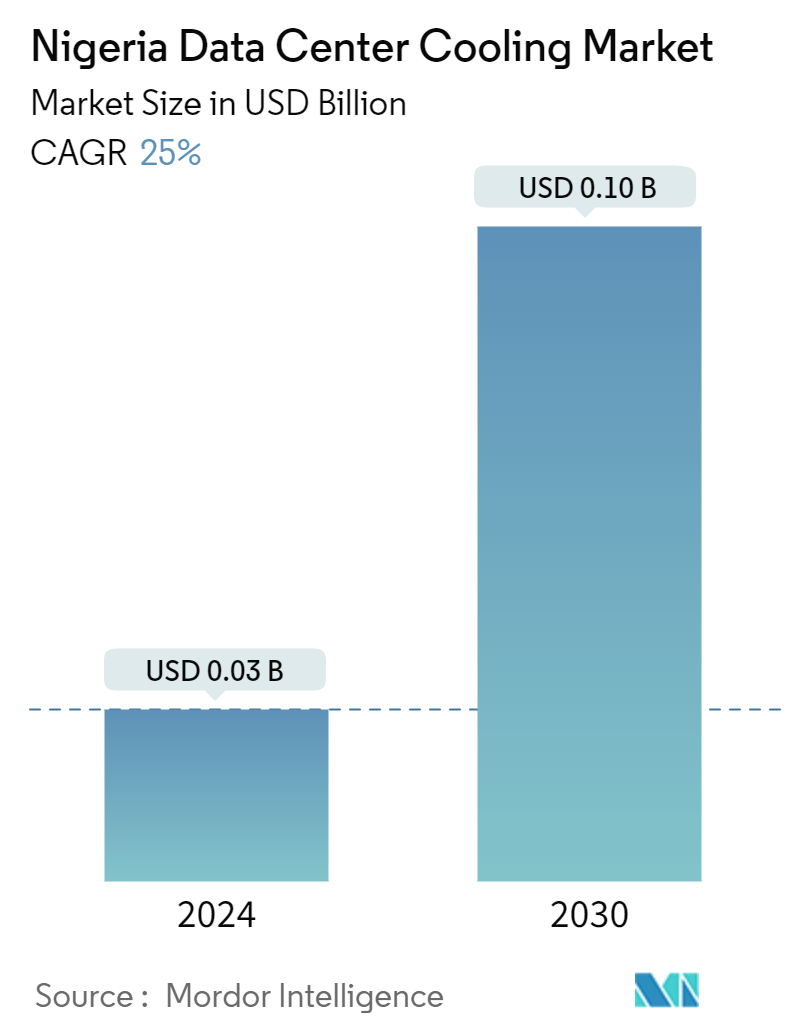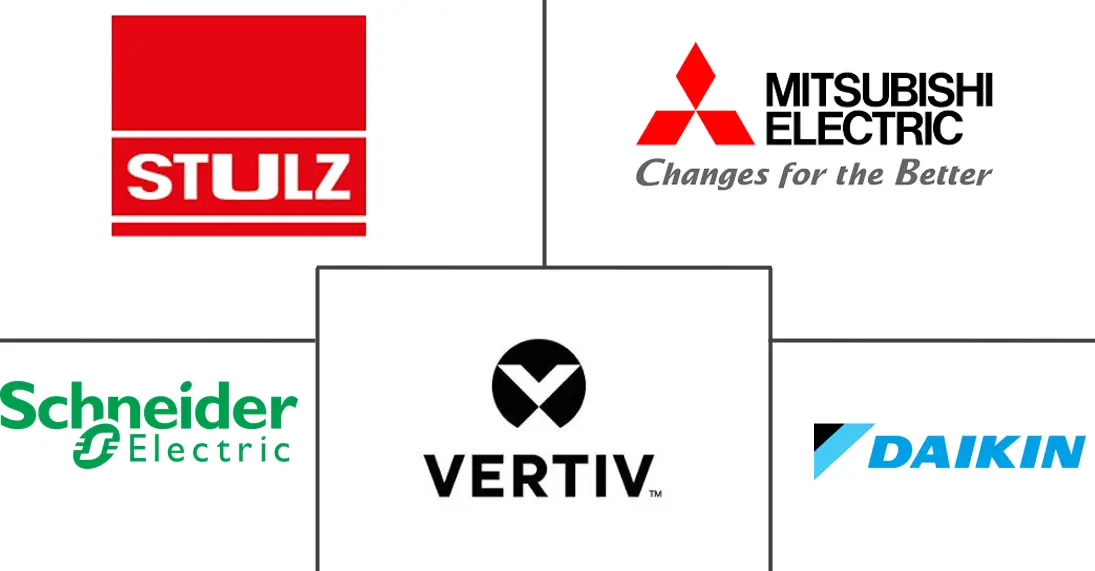Market Size of Nigeria Data Center Cooling Industry

| Study Period | 2017 - 2030 |
| Base Year For Estimation | 2023 |
| Market Size (2024) | USD 0.03 Billion |
| Market Size (2030) | USD 0.1 Billion |
| CAGR (2024 - 2030) | 25.00 % |
| Market Concentration | Medium |
Major Players
*Disclaimer: Major Players sorted in no particular order |
Nigeria Data Center Cooling Market Analysis
The Nigeria Data Center Cooling Market size is estimated at USD 0.03 billion in 2024, and is expected to reach USD 0.10 billion by 2030, growing at a CAGR of 25% during the forecast period (2024-2030).
- Nigeria is swiftly solidifying its position as a key data center hub in Africa. This momentum is fueled by the nation's dedication to digital transformation and its embrace of cutting-edge technologies like IoT, big data, AI, ML, and enhanced network connectivity.
- Under Construction IT Load Capacity: The upcoming IT load capacity of the Nigeria data center market is expected to reach more than 480 MW by 2030.
- Under Construction Raised Floor Space: The country's construction of raised floor area is expected to increase above 1.7 million sq. ft by 2030.
- Planned Racks: The country's total number of racks to be installed is expected to reach above 86K units by 2030. Johannesburg is expected to house the maximum number of racks by 2030.
- Planned Submarine Cables: Many are under construction. 2Africa, which stretches over 45,000 kilometers and has landing points in Lagos, Nigeria, was estimated to start service in 2023.
- New data centers across the country are focusing on implementing state-of-the-art monitoring systems to mitigate the risks associated with extreme weather events. Many would use the latest, more energy-efficient cooling technologies, such as redundant cooling systems, smart monitoring technologies, and backup power generators, to ensure consistency of temperature in the event of power interruptions. Another example is direct liquid cooling, which uses a higher thermal transfer of water to a more efficient cooling device.
- The average winter temperature is between 32°C (90°F) and 34°C (94 °F). The average summer temperature is between 42.9°C (109.22 °F) to over 44.5 °C (112.1°F). Depending upon climatic conditions, the DC cooling is done in the DC facilities.
Nigeria Data Center Cooling Industry Segmentation
Data center cooling is a set of techniques and technologies to maintain optimal operating temperatures in data center environments. This is important because data centers house many computer servers and network equipment that generate heat during operation. Efficient cooling systems are used to dissipate this heat and prevent equipment from overheating, ensuring continued reliable operation of the data center. Various methods, such as air conditioning, liquid cooling, and hot/cold aisle containment, are commonly used to control temperature and humidity in data centers.
The Nigerian Data Center cooling market study comprises by Technology (Air-based cooling (Chiller and Economizer, CRAH, Cooling Towers and Others), Liquid-based cooling (Immersion Cooling, Direct-to-chip Cooling, Rear-Door Heat Exchanger)), Type of Data Center (Hyperscaler, Enterprise and Colocation) , by End-User Industry (IT & Telecom, Retail & Consumer Goods, Healthcare, Media & Entertainment, Federal & Institutional agencies, and Other end-users).
| By Cooling Technology | ||||||
| ||||||
|
| By Type | |
| Hyperscalers (owned & Leased) | |
| Enterprise (On-premise) | |
| Colocation |
| By End user Vertical | |
| IT & Telecom | |
| Retail & Consumer Goods | |
| Healthcare | |
| Media & Entertainment | |
| Federal & Institutional agencies | |
| Other end-users |
Nigeria Data Center Cooling Market Size Summary
The Nigeria data center cooling market is poised for significant growth, driven by the increasing demand for cloud computing, government regulations on local data security, and substantial investments from domestic players. The market is characterized by the construction of new data centers that are implementing advanced cooling technologies to address the challenges posed by extreme weather conditions. These facilities are adopting energy-efficient cooling solutions, such as redundant cooling systems and direct liquid cooling, to maintain optimal temperatures and ensure operational continuity during power interruptions. The strategic location of Lagos, with its advanced network infrastructure and trade-free zones, further enhances the market's growth potential by attracting more organizations to leverage data center capabilities for specialized deployments.
The market landscape is fragmented, with major players like Schneider Electric SE, Rittal GMBH & Co.KG, and Mitsubishi Electric Hydronics & IT Cooling Systems SpA leading the charge in providing innovative cooling solutions. Recent partnerships and acquisitions, such as Carrier Global Corporation's collaboration with Strategic Thermal Labs and Vertiv's acquisition of Cooltera Ltd, highlight the ongoing advancements in cooling technologies. These developments are expected to enhance the efficiency and scalability of data center operations in Nigeria. As the demand for cloud services continues to rise, particularly in sectors like government, e-commerce, and BFSI, the data center cooling market is set to expand, supported by government initiatives and the growing need for local data hosting solutions.
Nigeria Data Center Cooling Market Size - Table of Contents
-
1. MARKET INSIGHTS
-
1.1 Market Overview
-
1.2 Key cost considerations for Cooling
-
1.2.1 Analysis of the key cost overheads related to DC operations with an eye on DC Cooling
-
1.2.2 Comparative Study of the cost and operational considerations related to each Cooling technology based on key factors such as design complexity, PUE, advantages, drawbacks, extent of utilization of natural weather conditions)
-
1.2.3 Key innovations and developments in Data Center Cooling
-
1.2.4 Key energy efficiency practices adopted in Data Centers
-
-
-
2. MARKET SEGMENTATION
-
2.1 By Cooling Technology
-
2.1.1 Air-based Cooling
-
2.1.1.1 Chiller and Economizer
-
2.1.1.2 CRAH
-
2.1.1.3 Cooling Tower (covers direct, indirect & two-stage cooling)
-
2.1.1.4 Others
-
-
2.1.2 Liquid-based Cooling
-
2.1.2.1 Immersion Cooling
-
2.1.2.2 Direct-to-Chip Cooling
-
2.1.2.3 Rear-Door Heat Exchanger
-
-
-
2.2 By Type
-
2.2.1 Hyperscalers (owned & Leased)
-
2.2.2 Enterprise (On-premise)
-
2.2.3 Colocation
-
-
2.3 By End user Vertical
-
2.3.1 IT & Telecom
-
2.3.2 Retail & Consumer Goods
-
2.3.3 Healthcare
-
2.3.4 Media & Entertainment
-
2.3.5 Federal & Institutional agencies
-
2.3.6 Other end-users
-
-
Nigeria Data Center Cooling Market Size FAQs
How big is the Nigeria Data Center Cooling Market?
The Nigeria Data Center Cooling Market size is expected to reach USD 0.03 billion in 2024 and grow at a CAGR of 25% to reach USD 0.1 billion by 2030.
What is the current Nigeria Data Center Cooling Market size?
In 2024, the Nigeria Data Center Cooling Market size is expected to reach USD 0.03 billion.

